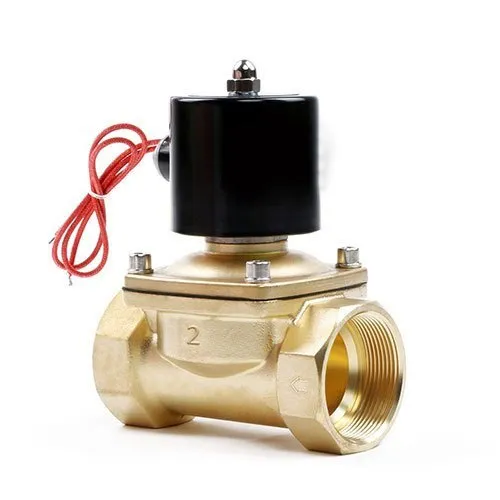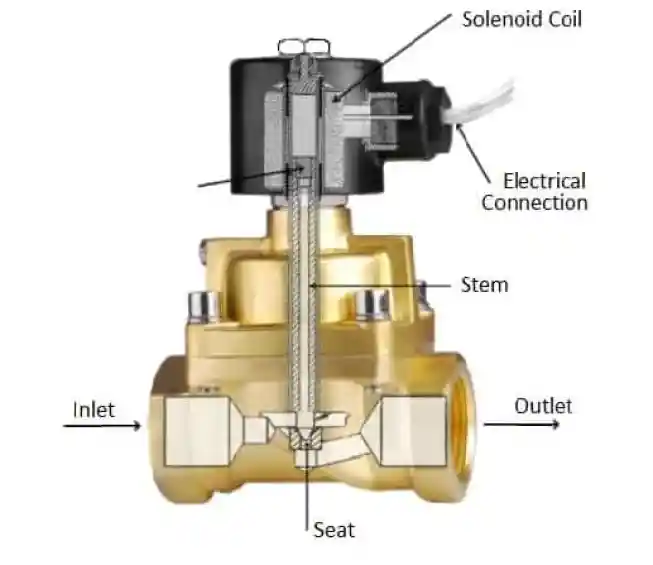
I.WHAT ARE SOLENOID VALVES?
A solenoid valve is a pressure-operated valve that uses an electromagnet to open and close a valve.
It may compare the principle of operation of a solenoid valve to that of an electric motor. Still, in this case, instead of being directly connected to its shaft (as with an electric motor), it is connected through electrical contacts connected to one or more other electrical circuits.
II.WHAT ARE COMPONENTS OF SOLENOID VALVES?
A solenoid valve‘s components are the heart of its operation. It can separate a solenoid valve into two major parts: the solenoid and the valve body. The solenoid is just one type in various actuators, such as manual, pneumatic, hydraulic, etc. The solenoids have varying parts depending on the kind of action required. The valve body components are also different, but they all have the same design and materials. Each part has its purpose in the process of controlling fluid flow.

Coil
A coil is one of the solenoid’s central parts, consisting of an insulated copper wire wound tightly around a core tube. As described earlier, a magnetic field is generated when the current is applied. The coil is used to produce a magnetic field that it can use to attract or repel other magnets.
Core
The core of a solenoid is the moving part of the device. It is a soft magnetic metal that can easily magnetize and demagnetize at low magnetic fields. When the coil is energized and generates a magnetic field, the core is attracted, opening or closing the valve.
Core Spring
Upon removing the magnetic field, the core spring returns the core to its original position. The design and configuration of the center spring in the solenoid assembly vary depending on the operation of the valve. Some structures, such as the latching type solenoid valves, it does not use springs to create a return action.
The latching-type solenoid valves are designed to operate at high pressures and temperatures. A return spring is used in these valves to ensure that the core will not be pulled out of position by centrifugal force. The return spring has two functions: firstly, it provides a means for returning the core to its original position when there is no longer a magnetic field present; secondly, it also provides a means to prevent excessive wear on the return spring itself over time due to repeated use with different operating conditions such as other pressures or temperatures.
Core Tube
The coil is wound between the rollers of a core tube, which acts as a soft magnetic core and a winding guide. The coil’s magnetic flux is improved by the presence of this core, which also helps to keep it in place during winding.
Fixed Core
This core type is installed at the closed end of the core tube, improving the magnetic flux. Also, the material has a soft magnetic property.
Diaphragm
The diaphragm isolates the fluid from the solenoid assembly in a solenoid assembly. The diaphragm is designed to contain the pressure of the liquid.
Stem
The stem is a part of the valve where the core or plunger is attached. The coil attracts the core, and the stem moves along, activating the valve. Stems are made of steel and must be treated to prevent corrosion.
Disc
A disc block is a component of a solenoid valve that prevents fluid flow when the valve is closed. In some solenoid valve designs, diaphragms, bellows, or grippers are used instead of a disc to block fluid flow. Depending on the application, the disc is usually made of corrosion and erosion-resistant materials such as PTFE or stainless steel.
Seat
The seat is the orifice your valve closes against when you close it. Depending on the valve design, the seat may not be present like the disc. The valve seat is also made of materials that are resistant to corrosion and erosion.Once the seat or disc is damaged, the valve will pass and cannot stop the flow.
Seal
The seal, like the diaphragm, insulates the solenoid assembly and the external fluid environment. Depending on the application and the process fluid, various seal materials are available such as PTFE, FKM, NBR, and EPDM. Sealing is critical to any hydraulic system because it protects against leaks and water contamination. Sealing also ensures that hydraulic oil does not leak out of the system during startup or shutdown.
Bonnet
The bonnet is the part of the valve body that sits at the top of the valve. The center tube and stem extend through the bonnet and into the valve.
Body
The central part of the valve is the body, which holds the disc, diaphragm, seat, inlet, and outlet ports.
Bleed Orifice
A bleed orifice is a hole that allows a valve to open or close based on pressure from the line. A bleed orifice is installed on the diaphragm for indirect or semi-direct solenoid valves. Equalizing holes are used in some valve designs. The bleed port allows the valve to use line pressure to open or close.
Pilot Channel
The pilot channel is a part of the valve’s body that directs fluid flow through the body at low pressure, which can be used to activate other parts of the valve. For example, it may include the pilot channel in indirect-acting solenoid valves.
WHAT ARE MATERIALS AND CONSTRUCTION OF SOLENOID VALVE?
Stainless Steel Solenoid Valve
Stainless steel is a corrosion resistant steel. It contains at least 15 percent chromium and 0.01 percent carbon. It’s known for its high strength and durability, which makes it an excellent choice for things like kitchen appliances and high-end automobiles. Stainless steel can also withstand temperatures up to 840°F, but it can be corrupted by chloride ions if not treated with a higher grade of stainless steel.
Bronze Solenoid Valve
Bronze is an alloy of copper and tin. Bronze is more resistant to cracking than cast iron but less resistant to corrosion than stainless steel.
Brass Solenoid Valve
Brass has a higher melting point than bronze, making it more durable and malleable.
Cast Iron Solenoid Valve
Cast Iron is an excellent material, as it offers incredible strength but is prone to cracking due to low flexibility.
Polytetrafluoroethylene (PTFE) Solenoid Valve
Polytetrafluoroethylene (PTFE) is a thermoplastic fluoropolymer that has excellent chemical resistance. This material also has water-repellent properties, which make it suitable for ultra-clean and chemical applications.PTFE is used in various applications, including food packaging and thermal insulation.
Polyamide (PA)
Solenoid Valve
Polyamide (PA) offers good mechanical properties comparable to PVC and is resistant to salt water. Polyamide is a strong plastic material with good mechanical properties. It is used in many applications requiring high strength and excellent chemical resistance. Polyamide is a plastic that has many uses in industry. For example, you can use it for insulation materials, bags, cables, etc.
Polypropylene (PP)
Solenoid Valve
Polypropylene is a thermoplastic with comparable mechanical properties to steel and brass with better resistance to acids, salts, and alkalis. It’s also lightweight and can be easily molded into different shapes.
Polyphenylene Sulphide (PPS)
Solenoid Valve
Polyphenylene Sulphide (PPS) offers good performance at high temperatures with solid resistance to acids and alkalis.
Polyvinyl Chloride (PVC) Solenoid Valve
Polyvinyl chloride (PVC) is commonly used in aquariums and other aquarium-related applications. It is suitable for seawater use but has lower strength and low-temperature ratings than brass and copper.
Polyvinylidene Fluoride (PVDF)
Polyvinylidene Fluoride (PVDF) is a thermoplastic polymer, which can be molded, extruded, or injection molded into a wide array of shapes. It has outstanding mechanical properties and resistance to all chemicals, including acids and alkalis. However, this material is not suitable for high-temperature applications.






